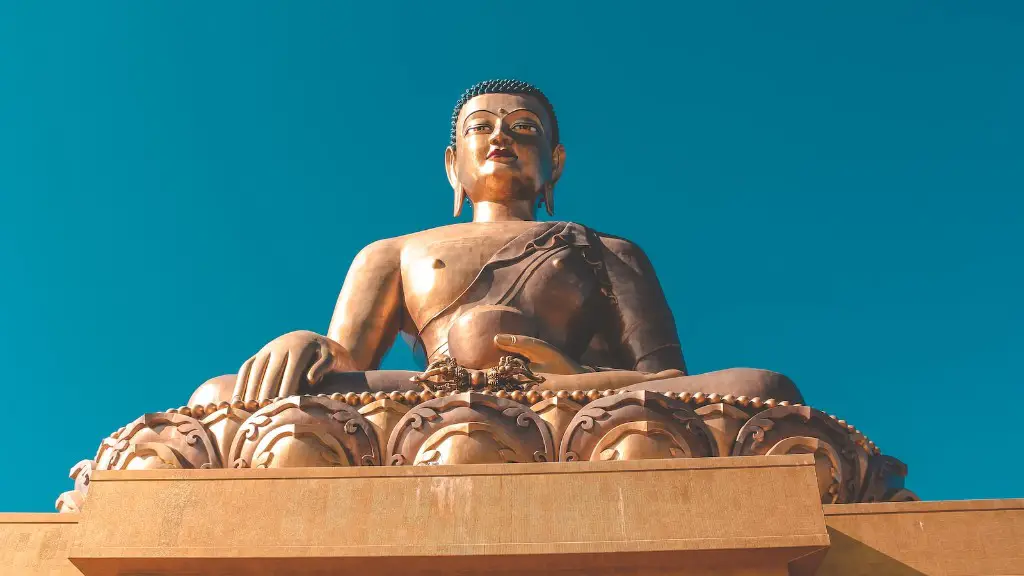Buddhism is a religion that began in India and spread throughout Asia. There are many different types of Buddhism, each with their own customs and beliefs. The type of Buddhism practiced in China is known as Mahayana Buddhism. This form of Buddhism stresses the importance of helping others and is focused on the Bodhisattva, or enlightened being, who postpones their own Nirvana in order to help others achieve it. Mahayana Buddhism is practiced by the majority of Buddhists in China and is also popular in Japan, Korea, and other parts of Asia.
There are many schools of Buddhism practiced in China, but the two main ones are Theravada and Mahayana. Theravada is the more traditional of the two, and is focused on the individual path to enlightenment. Mahayana Buddhism, on the other hand, is more focused on helping others achieve enlightenment.
What type of Buddhism is most prevalent in China?
Chinese Buddhism or Han Buddhism is a Chinese form of Mahayana Buddhism which has shaped Chinese culture in a wide variety of areas including art, politics, literature, . Han Buddhism is based on the teachings of the Buddha and is characterized by a number of distinctive features, such as the use of Chinese instead of Sanskrit, the focus on the layperson instead of the monastic life, and the adaptation of Buddhism to Chinese culture.
Buddhist thought in China has evolved significantly over the past thousand years. While it shares many similarities with its Indian counterpart, there are also many significant differences. Chinese Buddhists have developed their own unique interpretations of the teachings, and this has led to a very different form of Buddhism than what is found in India.
Is there Theravada Buddhism in China
The Dai minority is the only ethnic group in China that practices Theravada Buddhism, which is also the dominant form of Buddhism in Thailand, Myanmar, and Laos. As a result, the Dai people share many cultural and religious similarities with these other Southeast Asian peoples. For example, like the Thai and Lao, the Dai celebrate the Buddhist holiday of Wesak, which commemorates the Buddha’s birth, enlightenment, and death.
Mahayana Buddhism has played a significant role in China and it has a long and rich history. As Buddhism grew in the country, it adapted to and influenced the Chinese culture and a number of schools developed. The most well-known of these are the Pure Land, Chan (Zen) and Tian Tai schools. Each of these schools has contributed to Chinese culture in different ways, making Mahayana Buddhism an important part of China’s heritage.
Which is better Theravada or Mahayana?
There is no one answer to this question as it depends on the individual’s perspective. Some people may prefer Theravada Buddhism because of its more traditional approach, while others may prefer Mahayana Buddhism because of its more inclusive philosophy. Ultimately, it is up to the individual to decide which tradition is best for them.
The Dalai Lama is the highest authority in Tibetan Buddhism, and is respected as a religious leader by many. However, Tibetan Buddhism is more hierarchical in its structure, with the Dalai Lama at the top of the hierarchy. Chinese Buddhism, on the other hand, has no recognized top authority and is more decentralized. This lack of a centralized authority makes it difficult for Chinese Buddhists to agree on certain issues, such as doctrine and practice.
Why is Chinese Buddhism different?
One of the most significant differences between Chinese Buddhism and the original Buddhist teachings is the belief that Buddha is not just a teacher who taught followers what to do, but a god to be prayed to for help and salvation. This belief is a result of the Chinese people’s polytheistic religious background and the need for a personal god to appeal to for help. Additionally, Chinese Buddhism has more of a focus on ancestor worship than original Buddhism.
The way in which different cultures express their faith can vary widely. For instance, the Chinese tend to focus mainly on status when expressing their faith, while the Japanese may place more emphasis on poetry and paintings. This difference is likely due in part to the fact that Japanese Buddhist art was supported by the government during its development, while the Chinese government did nothing to support the development of Chinese Buddhist art.
Why did the Chinese not like Buddhism
Confucian intellectuals such as Han Yu railed against Buddhism for undermining the social structure of China. They claimed it eroded the loyalty of son to father, and subject to ruler, by encouraging people to leave their families and to become monks and nuns.
Buddhism first arrived in China during the Han dynasty, through the Silk Road. The Kushan Empire was a major center of Buddhist activity and the rise of Mahayana Buddhism in Asia can be traced back to this period. Since then, Buddhism has had a profound impact on Chinese culture and society.
What are the differences between Theravada and Mahayana Buddhism?
There is a key difference between Theravada and Mahayana Buddhists when it comes to their goals. Theravada Buddhists strive to become Arhats and gain freedom from the cycle of samsara, while Mahayana Buddhists may choose to stay in the cycle of samsara out of compassion for others. This difference stems from the different emphasis each tradition puts on personal liberation versus the liberation of all beings. For Theravada Buddhists, the focus is on their own personal liberation, while Mahayana Buddhists focus on the liberation of all beings.
There were many similarities between Buddhist and Taoist practices, which made it easier for Buddhist monks to explain Buddhism to the Chinese people. Buddhism also had a profound influence on Taoism, shaping its institutional structure.
What is the main religion in China
Chinese Buddhism has often been syncretized with Confucianism and Taoism, and since the Communist revolution in 1949, it has also been adapted to the state ideology of socialism. In the generations since, Chinese Buddhism has been greatly influenced by Folk Religions, which often intermingle with the Buddhist practices and beliefs. As a result, the Chinese Buddhist landscape is a complex and diverse one, with a wide variety of schools and sub-traditions.
Taoism is an ancient Chinese religion that stresses living in harmony with the Tao, or the natural order of the universe. However, during the Communist takeover in 1949, Taoism, Confucianism, and other religions were banned. This caused a decline in the practice of Taoism in China. Many modern Taoists live in Taiwan, although recent reforms in China have increased the number of Chinese Taoists.
What are the four types of Buddhism?
There are three main types of Buddhism: Theravada, East Asian Mahayana, and Tibetan Mahayana. Theravada Buddhism is the oldest and most traditional form of Buddhism, focused on the teachings of the historical Buddha. East Asian Mahayana Buddhism is a more popular and inclusive form of Buddhism, focused on the bodhisattva ideal of helping all sentient beings achieve awakening. Tibetan Mahayana Buddhism is a more mystical and ritualistic form of Buddhism, focused on tantric practices and the lineage of Tibetan lamas.
The Mahayana branch of Buddhism is the most popular form of Buddhist practice throughout Japan today with over 53% of practitioners compared with 36% for Theravada and just 6% for Vajrayana. Mahayana Buddhism emphasizes the role of the Bodhisattva, or enlightened being, who postpones his own Nirvana in order to assist all other sentient beings in achieving liberation from suffering. This emphasis on compassion as the supreme virtue has made Mahayana Buddhism particularly appealing to the Japanese people.
Is Vietnamese Buddhism Theravada or Mahayana
Buddhism became the religion of Vietnam after Chinese rule in the country ended in the 10th century CE. Even though Buddhism had been practiced in Vietnam for centuries, it was not until the 10th century that it became the state religion. The Chinese rulers who preceded the Vietnamese did not promote Buddhism, but they did not suppress it either. When the Chinese rule ended, the Vietnamese people were able to practice their own religion, which was Buddhism. Buddhism has had a significant impact on Vietnamese culture, art, and architecture.
Mahayana or “Greater Vehicle” Buddhism is the branch of Buddhism that found its way to Japan. It consists of the teachings of the Buddha, Gautama Siddhartha.
Conclusion
There is no single answer to this question as there is considerable diversity in the Chinese Buddhist tradition. However, some of the more common types of Buddhism practiced in China include Pure Land Buddhism, Chan (Zen) Buddhism, and Vajrayana (Tantric) Buddhism.
The majority of Buddhists in China practice what is known as Mahayana Buddhism. This type of Buddhism teaches that all beings are capable of achieving enlightenment and that there is not just one path to salvation. Mahayana Buddhism also emphasizes the importance of helping others achieve enlightenment.



